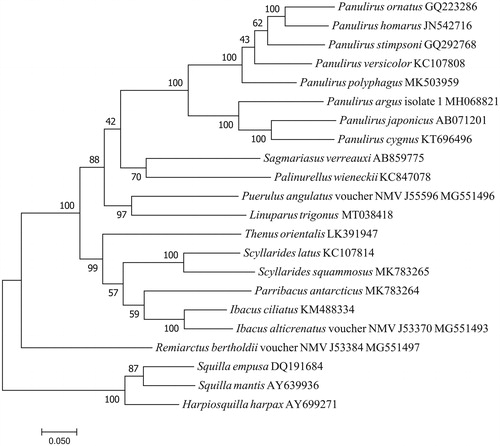Abstract
In this study, we first determined and characterized the complete mitochondrial genome of Japanese spear lobster Linuparus trigonus from South China Sea. The L. trigonus mitogenome is 15,949 bp long, and consists of 22 tRNA genes, 2 rRNA genes, 13 protein-coding genes (PCGs), and 1 control region. The nucleotide composition of L. trigonus mitogenome is significantly biased (A, G, T, and C was 32.80%, 12.01%, 32.63%, and 22.56%, respectively) with A + T contents of 65.43%. Two PCGs used an unusual initiation codon, and most PCGs were terminated with an abnormal stop codon except ATP8. Three microsatellites were identified in L. trigonus mitogenome sequences. Phylogenetic tree showed that L. trigonus was first clustered with Puerulus angulatus.
Linuparus trigonus, commonly known as the Japanese spear lobster or barking crayfish, is one of the three extant species in the genus Linuparus which belongs to the family Palinuridae (Holthuis Citation1991). It is known from both fossil and living forms, generally found in deep water between 30 and 318 m, and distributed in the Indo-West Pacific region including Japan, Korea, China, Taiwan, Philippines, Indonesia and Australia (Holthuis Citation1991). They are sold in the markets as food, but is nowhere plentiful. Early studies focused on its mechanism of sound production and the underwater sounds produced by it (Takemura Citation1971), its gametogenesis, reproductive cycle, and embryonic development (KIM Citation1977), and the diel feeding-periodicity and composition of its diets (Wassenberg and Hill Citation1989). Recently, the researchers have paid more attention to its fishery and reproductive biology including sex ratio, size at maturity, size-specific brood fecundity and egg size (Haddy et al. Citation2003), maturation and spawning (Lee et al. Citation2009), and its biogeography and phylogenetic relationships (Palero et al. Citation2009; Tsoi et al. Citation2011).
The specimens were collected from Qizhoulie islands of Wenchang, China (N19°57′32.17″, E111°15′22.68″), and stored in the marine crustacean specimen room (C20191208LT) in Qionghai research base of Hainan Academy of Ocean and Fisheries Sciences, Muscle samples of L. trigonus were preserved in absolute ethanol for reference.
The whole mitogenome of L. trigonus is 15,949 bp in size (GenBank Accession No. MT038418). The base content was 32.80% A, 12.01% G, 32.63% T, and 22.56% C. The 65.43% of (A + T) showed great preference to AT. It consists of 22 tRNA genes, 2 rRNA genes, 13 protein-coding genes (PCGs), and 1 control region (D-loop). Four PCGs (ND1, ND4, ND4L and ND5), eight tRNA genes, and two rRNA genes were located on the light strand, the others were encoded by the heavy strand.
The 22 tRNA genes in L. trigonus mitogenome vary in length from 51 bp to 72 bp. tRNA-Leu and tRNA-Ser both have two type copies. The 12S rRNA is 831 bp and located between tRNA-Val and D-loop, and the 16S rRNA is 1375 bp, located between tRNA-Val and tRNA-Leu. Except ND2 and COX1 using an unusual CTT and CGA as the start codon, respectively, the others use a normal initiation codon ATN or TTG. Simultaneously, most PCGs were terminated with an unusual codon in addition to ATP8 genes using a normal stop codon. The control region is 807 bp, located between 12S rRNA and tRNA-Ile. Interestingly, we identified three microsatellites (SSRs) in L. trigonus mitogenome using MISA. A(C)12 are located in D-loop region, and two (A)10 are located in NAD2 and NAD4L genes.
A maximum likelihood phylogenetic analysis with 19 crustacean mitogenomes placed L. trigonus among Achelata species with 1000 bootstrap replicates. The result () showed that L. trigonus was first clustered with Puerulus angulatus, and further clarified the phylogenetic relationships of the genus Linuparus in the family Palinuridae. It was consistent with the previous work by single mitochondrial fragments(Palero et al. Citation2009; Tsoi et al. Citation2011).
Harpiosquilla harpax, Squilla empusa, and Squilla mantis were used as outgroups.
Disclosure statement
No potential conflict of interest was reported by the author(s).
Additional information
Funding
References
- Haddy J, Roy D, Courtney A. 2003. The fishery and reproductive biology of barking crayfish, Linuparus trigonus (Von Siebold, 1824) along Queenslands East Coast. Crustaceana. 76(10):1189–1200.
- Holthuis LB. 1991. Marine lobsters of the world. FAO Fisheries Synopsis 13, I. Rome, Italy: Food and Agriculture Organization of the United Nations.
- Kim C-H. 1977. Gametogenesis and early development of Linuparus trigonus (Von Siebold). Kor J Fish Aquat Sci. 10:71–96.
- Lee H-N, Choi J-H, Im Y-J, Yoo J-T, Oh T-Y, Kim J-N. 2009. Maturation and spawning of Japanese spear lobster, Linuparus trigonus (Von Siebold) in Jeju Island. J Kor Soc Fish Ocean Technol. 45(4):287–291.
- Palero F, Crandall KA, Abelló P, Macpherson E, Pascual M. 2009. Phylogenetic relationships between spiny, slipper and coral lobsters (Crustacea, Decapoda, Achelata). Mol Phylogenet Evol. 50(1):152–162.
- Takemura A. 1971. Studies on underwater sounds III. On the mechanism of sound production and the underwater sounds produced by Linuparus trigonus. Mar Biol. 9(2):87–91.
- Tsoi KH, Chan T-Y, Chu KH. 2011. Phylogenetic and biogeographic analysis of the spear lobsters Linuparus (Decapoda: Palinuridae), with the description of a new species. Zoologischer Anzeiger. 250(4):302–315.
- Wassenberg T, Hill B. 1989. Diets of four decapod crustaceans (Linuparus trigonus, Metanephrops andamanicus, M. australiensis and M. boschmai) from the continental shelf around Australia. Mar Biol. 103(2):161–167.

